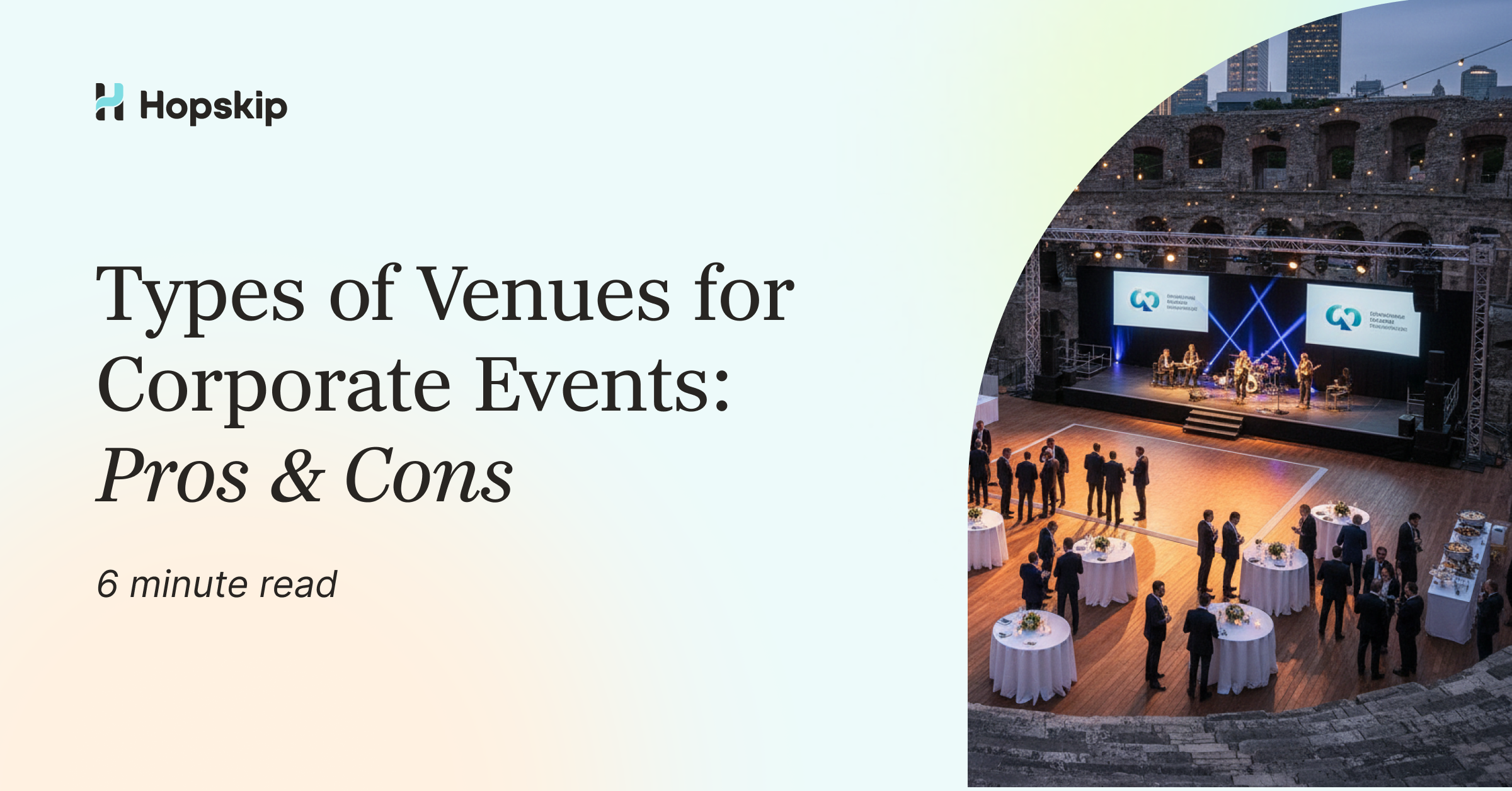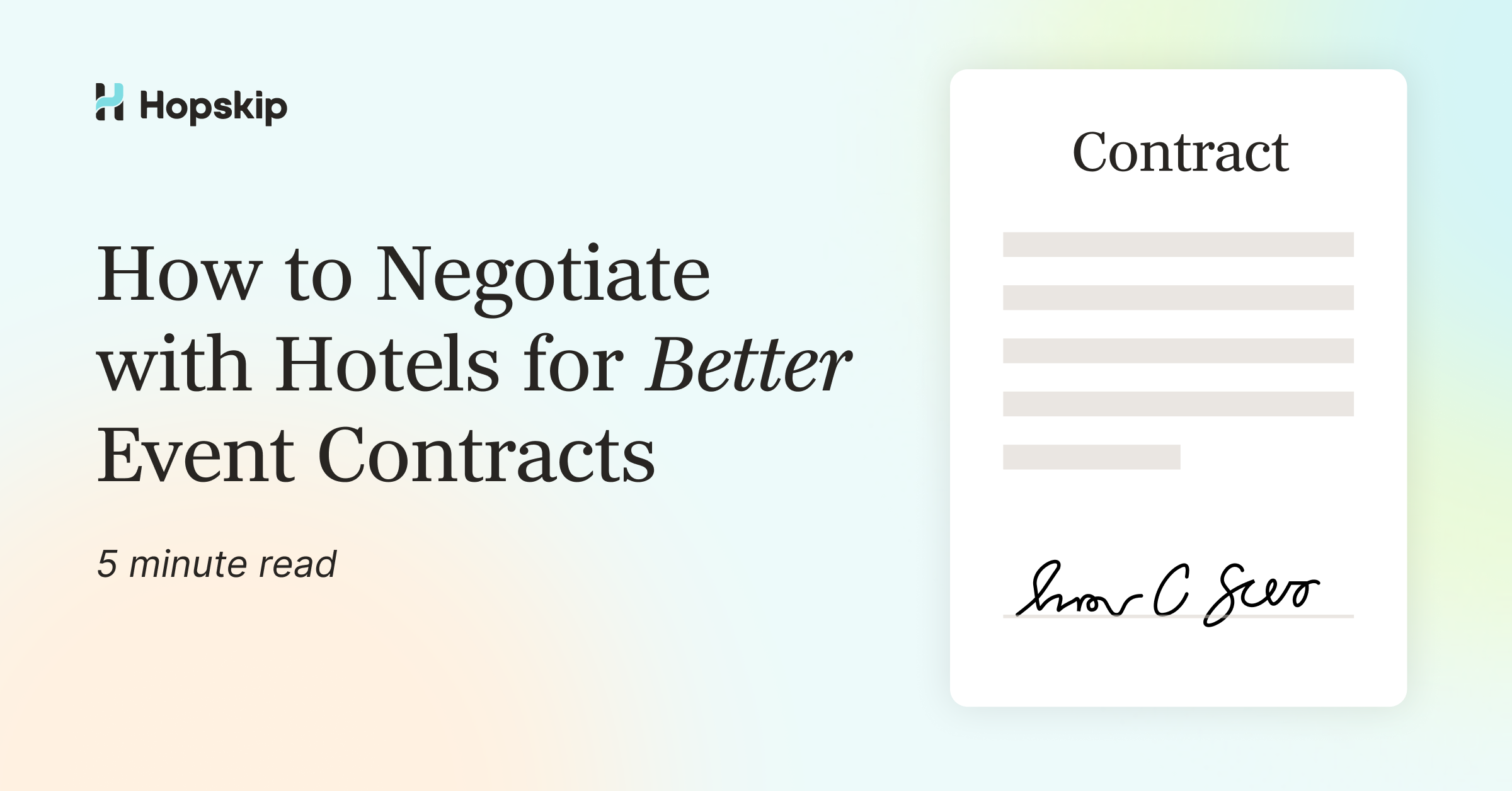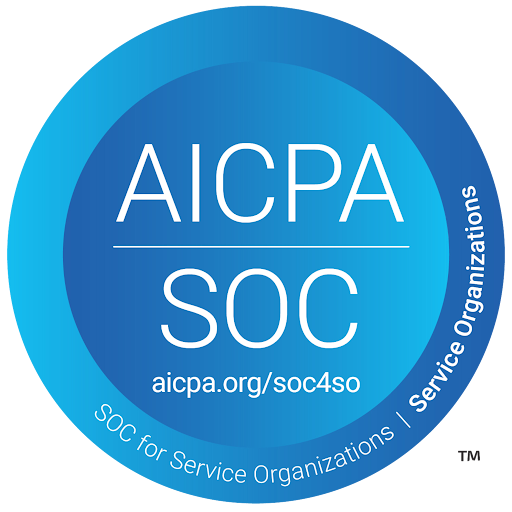How to Evaluate Hotel Proposals Without Losing Your Mind (Or Your Budget)
Whether you're wrangling proposals for a 300-person conference or selecting the perfect venue for an executive retreat, the evaluation process can feel like decoding the Da Vinci Code while juggling flaming torches. Here's how to do it without losing your mind.
Introduction
Picture this: You're three coffee cups deep, staring at your third hotel proposal of the day, and they all look suspiciously similar. One promises "state-of-the-art AV capabilities" (spoiler: it's a projector from 2015), another boasts "flexible event spaces" (translation: we'll move some chairs around), and the third just sent you a PDF that's clearly a wedding package with "WEDDING" poorly edited out.
Welcome to the glamorous world of evaluating hotel proposals for corporate events.
As an event planner responsible for delivering seamless business events, you're not just comparing apples to apples—you're comparing apples to oranges to that mystery fruit nobody can identify. Whether you're wrangling proposals for a 300-person conference or selecting the perfect venue for an executive retreat, the evaluation process can feel like decoding the Da Vinci Code while juggling flaming torches.
Here's the thing: you need more than just a good feeling about a venue. You need metrics, data, and a systematic approach that'll make your CFO weep tears of joy. In this guide, we'll walk through the key metrics for evaluating hotel proposals so you can present recommendations with confidence.
At Hopskip, we speak fluent planner—we know you care about ROI, attendee experience, schedule integrity, and making sure the WiFi doesn't crash during the CEO's keynote. Let's dive in.
1. Aligning the Venue to Your Event Objectives (AKA: Does This Hotel Actually Get It?)
Before you get seduced by marble lobbies and complimentary breakfast buffets, ask yourself: Does this hotel understand what you're actually trying to do?
Here's a secret: most hotels don't read your RFP beyond the dates and headcount. They're sending generic proposals like mass texts to their entire contact list. Your job? Spot the difference between a venue that gets your vision and one that just copy-pasted last month's wedding package.
When reviewing proposals, ask:
- Does the hotel reference your stated objectives? If you said "plenary hall + breakout spaces + networking lounge" and they responded with "ballroom available," that's a red flag.
- Is there proof they've hosted similar events? Look for specifics like "We hosted XYZ supplier conference with 400 attendees" versus vague "experienced in corporate events" claims.
- Does the language match your event type? Corporate proposals should mention "client meeting rooms" and "networking breakouts"—not "sweetheart table placement."
If a proposal fails this foundational check, you're setting yourself up for an event where the hotel treats your important business conference like someone's cousin's reception.
According to event industry best practices, success starts with defining your event's success criteria upfront.
Pro Tip: Create a short "must-have" list of your event objectives before issuing the RFP. When proposals roll in, use a simple table (Objective vs Venue Match) to judge alignment. It's like a dating profile compatibility quiz, but with more spreadsheets and fewer photos of people holding fish.
2. Cost Metrics & Financial Value – The "It's Not Just About the Room Rate" Reality Check
Here's what usually happens: You get a proposal with an attractively low room rate, and for three glorious seconds, you think you've found the holy grail. Then you scroll down and discover the hidden fees section looks like a CVS receipt—endless, incomprehensible, and somehow including charges for things you didn't even know existed.
Evaluating hotel proposals goes way beyond the nightly rate. Consider:
- Total event cost per attendee: Sum of room block + F&B + AV + ancillary fees, divided by expected headcount. This is your reality check number.
- Hidden fees: High F&B minimums, service charges, mandatory staffing fees, and AV costs that could fund a small indie film.
- Budget variance risk: Hotels assume 90% attendance, but if your data shows 70%, that gap becomes your problem.
- Value vs. commoditized cost: The cheapest option often costs more through lost attendee engagement and weaker AV capabilities.
The hospitality sector increasingly demands data-driven ROI, meaning planners must look beyond cost to actual value.
Pro Tip: Build a cost matrix comparing at least three proposals. Show not just the rate but all estimates plus assumptions, and include a scenario column for 20% lower attendance than projected. Future you will thank present you when someone asks "but what if only 200 people show up instead of 250?"
3. Venue Capacity, Flow & Logistics – Where the Magic (Or Chaos) Happens
Let's talk about space—specifically, how your attendees will move through it without feeling like they're navigating IKEA on a Saturday afternoon.
With events, physical space and flow matter enormously. When evaluating venue proposals, focus on:
- Space utilization ratio: Net usable breakout space per attendee. Cramming 50 people into a room designed for 30 creates claustrophobia, not intimacy.
- Breakout/flow efficiency: Does the floor plan support your agenda without requiring attendees to train for a 5K between sessions?
- Technical/AV infrastructure: Demand specifics—dedicated bandwidth, live-stream capability, projection counts, on-site tech support hours. "AV available" tells you nothing.
- Flexibility metrics: What happens if attendance doubles or you need an extra breakout room? The proposal should provide scalability options.
Real-world example: A conference plans for 500 attendees, but drop-outs happen. The hotel with an oversized ballroom might save you from last-minute reallocation and minor panic attacks.
Pro Tip: Ask each venue for a detailed floor plan diagram showing breakout sizing and walking times between rooms. Add a "logistics score" column to your evaluation matrix. If a hotel can't provide this, question whether they're taking your event seriously.
4. Attendee Experience & Engagement Metrics – Because Happy Attendees = Happy You
Nobody remembers the exact thread count of hotel linens, but they will remember if check-in took 45 minutes, the coffee ran out by 9am, or the WiFi was slower than dial-up circa 1998.
For corporate events, attendee experience drives value. Use these metrics:
- Ease of arrival/departure: Airport proximity and transport links matter. A complicated commute tanks satisfaction scores before your event begins.
- Food & beverage experience: Your delegates expect quality coffee (non-negotiable), quick service flow, and healthy options. The proposal should include sample menus and service cadence.
- Technology & connectivity: The proposal should specify WiFi speeds (Mbps), simultaneous user capacity, and what happens when someone's laptop refuses to connect.
- Sustainability and wellness: Many corporate planners now include green meeting certifications, offset programs, and wellness options as part of experience metrics.
Industry sources emphasize that engagement and satisfaction rank among the strongest KPIs for events today.
Pro Tip: Score each hotel on "attendee experience potential" using a 1-10 scale based on logistics, tech, networking spaces, and F&B quality. Use this as a tiebreaker when cost or availability is similar.
5. Risk & Contingency Metrics – Planning for Murphy's Law
If you've planned more than three events, you know the universe has a sense of humor. Snowstorms happen. Speakers cancel. Technology fails at the worst possible moment.
When evaluating venue proposals, you're hedging against disaster. Check these risk metrics:
- Attrition policy: What's the minimum attrition percentage before penalties kick in? The proposal should state cost per room or meal if numbers drop.
- Cancellation/force majeure terms: Does the proposal define handling for weather, travel disruptions, or pandemics?
- Staffing reliability: Does the hotel provide backup if their key AV person calls in sick? Look for vendor response times and escalation paths.
- Room block flexibility: Can you release unused rooms up to a certain date without penalties?
Proposals that bury risk metrics in fine print are waving red flags while trying to hide them.
Pro Tip: Add a "risk score" to your evaluation matrix. For each proposal, assign 1-5 points based on contingencies, flexibility, and vendor reliability. Factor this into your "net value" score to reflect risk-adjusted value.
6. Comparative Metrics & Competitive Benchmarking – May the Best Venue Win
Since you're likely comparing multiple proposals (if you're not, start—one proposal is not a competitive process), you need metrics that facilitate actual comparison rather than gut feelings.
Consider:
- Cost per usable square metre: Normalize venue cost by usable space to compare bang for your buck.
- Room block utilization vs. cost: Higher blocks with lower usage raise your effective cost and attrition risk.
- Turnover time: The proposal should state actual reset times between your sessions, not just "we're very efficient."
- Innovation and value-adds: Compare complimentary extras like dedicated tech support, high-speed WiFi, mobile app integration, or sustainability credits.
Hotel proposals often focus on rate rather than value. Your job? Find venues that deliver both.
Pro Tip: After scoring each hotel across all sections, create a composite scorecard. Use weighted scoring—for example, cost 40%, attendee experience 25%, logistics 15%, risk 10%, value-adds 10%—to make a data-driven recommendation. When stakeholders ask why you chose Venue B over Venue A, you'll have receipts.
7. Implementation & Follow-Through Metrics – From Paper Promises to Reality
Securing the venue is only phase one. What actually matters is whether the hotel honors the metrics you used during evaluation.
To protect yourself and your reputation, ensure these elements are clear:
- Contract KPIs: Translate key metrics into contract deliverables—minimum WiFi speed, setup completion time, room block release date, coffee replenishment frequency. If it's not in the contract, it's just a friendly suggestion.
- Post-event review metrics: Compare attendance versus block projections, catering satisfaction, technical issues, and overall guest experience. This ensures continuous improvement.
- Closing the loop: After the event, compare actual performance versus proposal metrics. Use this feedback for your next evaluation cycle.
As the events industry becomes increasingly accountable to business outcomes, planners who track and enforce implementation metrics gain credibility and negotiating power.
Pro Tip: Build a one-page "venue success scorecard" that you'll complete after the event. This holds the venue accountable, provides evidence for stakeholder debriefs, and creates documentation for your next venue selection cycle.
Conclusion
When evaluating venues for corporate or business events, remember: the venue proposal isn't just about room rates and pretty ballroom pictures. It's about how that hotel will help you deliver your event objectives—networking success, attendee satisfaction, budget efficiency, or brand reputation protection.
By systematically assessing alignment, cost/value, logistics, attendee experience, risk, competitive benchmarking, and implementation metrics, you position yourself to choose the venue that truly delivers. Not just the venue with the best brochure or the sales rep who remembered your name.
At Hopskip, we understand that planners don't have time for spreadsheets that don't align with business goals. Our platform streamlines how you compare venues, track metrics, and stay aligned to event objectives—all without the guesswork, headaches, or 3am panic about whether you remembered to confirm the AV setup.
Here's to smarter, metrics-driven venue decisions—and business events that run so smoothly, people might actually think you're not stressed. (You are. We know. But at least the venue isn't adding to it.)
Ready to see how Hopskip can transform your venue selection process? Book a demo with our team today.
Subscribe to our newsletter
Related Posts

The Ultimate Planner’s Guide: Decoding Corporate Event Venues—Pros and Cons of Every Type
A comprehensive guide to the pros and cons of the top corporate event venues (hotels, unique spaces, outdoor) written specifically for event planners. Optimize your budget and logistics.
.svg)





.svg)

